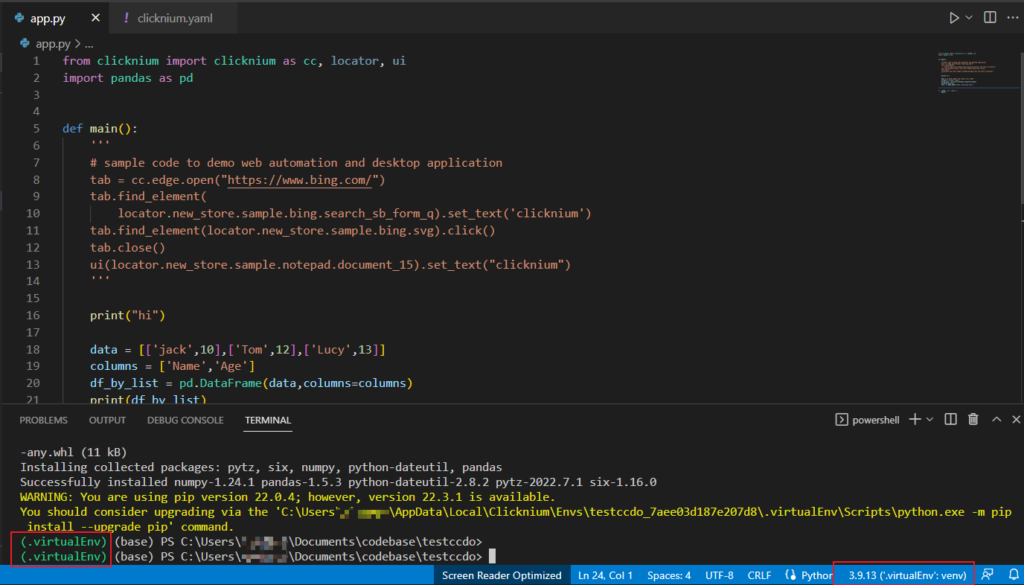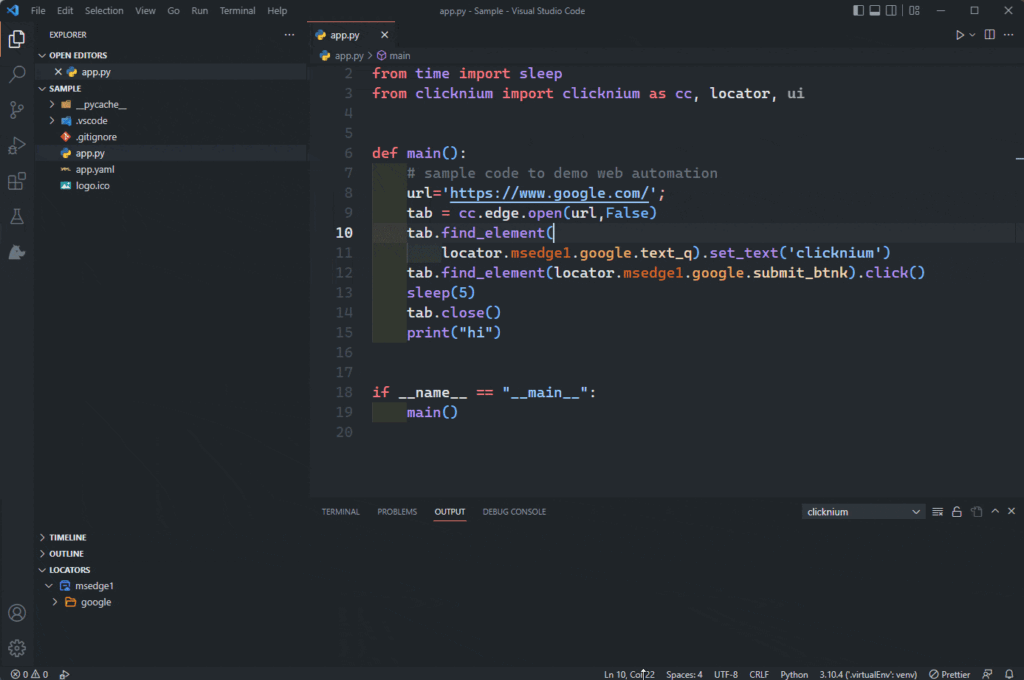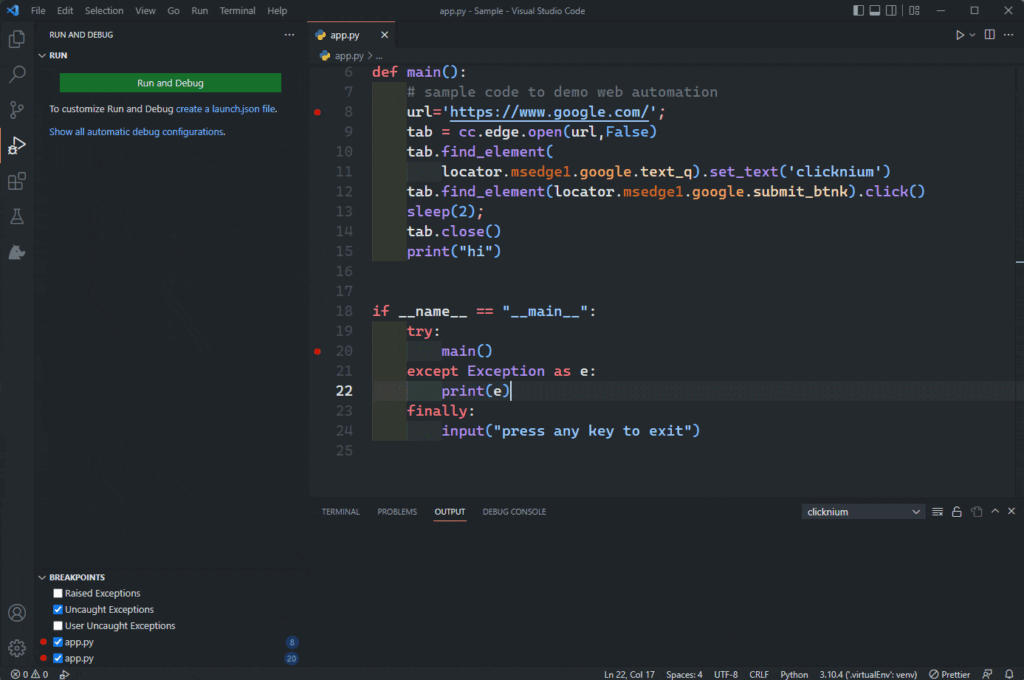1. Introduction #
If you are a Python programmer and have created automation scripts with Clicknium, you may need to share them with people who have no knowledge of programming and do not have Python installed on their system. In such a case, it is useful to package the Clicknium Python script into an executable file. Clicknium supports two methods of packing for this purpose.
- Clicknium Project Package
- PyInstaller
2. Clicknium Project Package #
2.1 Create Project #
In Visual Studio Code, press Ctrl+Shift+P to show the Command Palette, input Clicknium: Create Project, and then select a folder to store the project in the pop-up window. The command will also create a virtual Python environment for the project.

When the project is created, a pop-up window in the lower right corner shows the general project initialization information, and the output panel shows details. After initialization, the current Python virtual environment can be seen when you open app.py.

Compared to the ordinary Python project, there are a few more files:
- app.py: Python source code.
- logo.ico: Executable file’s Icon.
- clicknium.yaml: Configuration file.
app.py is the default Python code file. You can rename or edit it.logo. ico is the default Icon for the exe file. It can be replaced for customize. clicknium.yaml includes some settings about the target exe file.
2.2 Run the project #
In Visual Studio Code, press “Ctrl+Shift+P” to show the Command Palette, input or select Clicknium: Run Project. The Clicknium extension will deploy and run the project based on clicknium.yaml.

2.3 Debug the project #
In Visual Studio Code, set a breakpoint to the code, press Ctrl+Shift+P to show the Command Palette, and input Clicknium: Debug Project.

Useful Shortcut:
| Action | Shortcut |
|---|---|
| Run/Continue | F5 |
| Pause | F6 |
| Step over | F10 |
| Step in | F11 |
| Step out | Shift + F11 |
| Restart | Ctrl+Shift+F5 |
| Stop | Shift + F5 |
2.4 Project Package #
#
Package configuration: Package config is in the clicknium.yaml file:
startUp: app
ignoreFiles: .gitignore
log:
folder:
type: File
type: project
requirements:
python: 3.9.13
pip:
packages:
- package: clicknium
version:
- package: pandas
version: 1.5.3
locators: []app : the Python source code file with the entry point.log: the default log path is C:\Users\{currentUser}\AppData\Local\Clicknium\Log. Change the folder where you want to store the log file, etc. .\\ for the current path.python: The Python version to package into the exe file.packages: The dependencies of the script. The package name and version will be auto-included. If the auto-included process does not work, you need to manually add the Python libs into the file.
Build the executable file:
In Visual Studio Code, press Ctrl+Shift+P to show the Command Palette, input or select Clicknium: Package Project. There are two modes for the .exe file. If it’s a simple command-line script, choose console. If the Python Project included any GUI, choose gui. Next, select the path to save the executable file.

The detailed package log Output displays in the Output in Visual Studio Code.
Once the package is finished, the saving folder will be opened to show the target executable file.
3. Package by PyInstaller #
In addition to the built-in packaging method, a more common practice in Python development is to use the Pyinstaller: PyInstaller Manual.
To keep the project clean, it is still recommended to use a Python virtual environment for development. Typically, the Python virtual environment used for a project can be found by opening the settings.json file in the .vscode folder of the project file.

a. Go to the directory of the virtual environment and use pip install pyinstaller to install pyinstaller. use the pip list to see what pyinstaller is included and the specific version information.
b. Edit publish.spec

Configuration description:
- Project location:{$”project app.py full path”},input the full address of the project app.py, such as ‘c:\Users\{Username}\Desktop\Sample\app.py’
- Clicknium SDK address:($’clicknium .lib automation full path’, ‘clicknium\.lib\automation’),input Python virtual environment site-packages folder clicknium under.lib\automation,such as:binaries=[(‘C:\Users\{Username}\AppData\Local\Clicknium\Envs\Sample_17aea73e4ca65262\.virtualEnv\Lib\site-packages\clicknium\.lib\automation’, ‘clicknium\.lib\automation’)]
- Locator address:datas=[($’project .locator full path’, ‘.locator’)],input the .locator address of project, such as, datas=[(‘c:\Users\{Username}\Desktop\Sample\.locator’, ‘.locator’)]
- Executable file name:name=$’project name’, Fill in the package to generate exe name. You can fill in your own
The following is an example.:
# -*- mode: python ; coding: utf-8 -*-
block_cipher = None
a = Analysis(
['c:\Users\KayYOLO\Desktop\Sample\app.py'],
pathex=[],
binaries=[('C:\Users\KayYOLO\AppData\Local\Clicknium\Envs\Sample_17aea73e4ca65262\.virtualEnv\Lib\site-packages\clicknium\.lib\automation', 'clicknium\.lib\automation')],
datas=[('c:\Users\KayYOLO\Desktop\Sample\.locator', '.locator')],
hiddenimports=[],
hookspath=[],
hooksconfig={},
runtime_hooks=[],
excludes=[],
win_no_prefer_redirects=False,
win_private_assemblies=False,
cipher=block_cipher,
noarchive=False,
)
pyz = PYZ(a.pure, a.zipped_data, cipher=block_cipher)
exe = EXE(
pyz,
a.scripts,
a.binaries,
a.zipfiles,
a.datas,
[],
name='Sample',
debug=False,
bootloader_ignore_signals=False,
strip=False,
upx=True,
upx_exclude=[],
runtime_tmpdir=None,
console=True,
disable_windowed_traceback=False,
argv_emulation=False,
target_arch=None,
codesign_identity=None,
entitlements_file=None
)4. Run without the browser automation extension #
Web browser extension must be installed and enabled when developing the Clicknium web automation script. When developers deliver the script to business users, business users might not know how to install the Clicknium browser extension. The following code can check and install the extension.
if cc.chrome.extension.install_or_update():
print("Please open Chrome browser to enable clicknium extension, then run again.")
There is another option: Chrome DevTools Protocol(CDP). Clicknium supported CDP after version 0.1.12. Switch cc.chrome to cc.chromecdp to use the CDP APIs which can run without web automation extension.
# need to run with browser extension
chrome_tab = cc.chrome.open("https://www.bing.com")
# open Chrome browser with CDP
chrome_tab = cc.chromecdp.open("https://www.bing.com")



